- SEO
SEO Agency
Take advantage of the first traffic acquisition lever by entrusting your SEO to a digital agency experienced in SEO. - SEA
SEA Agency
Grow your business quickly with paid search (SEA).
- Social Ads
Social ads
Optimize your social media advertising campaigns to improve your performance.TikTok adsGo viral with your ads on TikTok

- Agency
The agency
Keyweo was born from the desire to create an agency that meets the principles of transparency, trust, experience and performance.
- Blog
- Contact
Search Volume
Home > SEO Agency > SEO Glossary > Search volume
Definition
The search volume indicates the number of search queries for a specific keyword. This can be used to determine the popularity of a keyword. Search volume is a very useful indicator for a good SEO strategy. It has many special features and subtleties. You should know these in order to make the right decision when choosing your search terms.
Search volume is an essential criterion for optimising your content. If you don’t take it into account, you won’t be able to answer users’ questions in the best possible way. Less relevance for users means less traffic to the website. With the right tools and a good strategy, you can get the most out of your content.

What is a keyword?
Anyone who talks about search volume must also talk about keywords. This is because we are always talking about the search volume of a specific keyword. To find a meaningful explanation for this, you need to understand what a ‘keyword’ is. It is the basic principle of any SEO strategy. This is because content should be offered that matches the user’s search intent. This is not possible without selecting relevant keywords. Keyword analysis is a fundamental step in content creation.
The seasonality of the keyword influences the search volume
Would you like to try your hand at keyword analysis? Then you should know that this metric is influenced by the type of search term selected. There are three types of keywords. If you understand these, you can better interpret fluctuations in search volume. This allows you to deliver content that is optimised for a specific context.
Regular
The regular ‘keyword’ – evergreen keyword – is searched for throughout the year. This means that the search volume is relatively stable. For example, the keyword ‘cake recipe’. It is searched for throughout the year and is therefore of regular relevance.

Seasonal
The seasonal keyword is only popular at certain times of the year. This can be at Christmas or Easter, for example. The search volume is subject to more irregular fluctuations.

Occasional
An occasional ‘keyword’ usually occurs for a specific event. After that, it is unlikely to see search volume for the keyword again. A good example is the keyword ‘Basketball World Cup 2019’. It was only popular between the end of August and the end of September 2019.

A special case: keywords with zero search volume.
If one day you come across a keyword with a search volume of zero, don’t panic! There is an answer to this riddle. Keywords with zero search volume do not mean that they do not generate traffic. On the contrary: although they bring traffic, Google doesn’t care. And because of this lack of concern, SEO tools display the result ‘zero’ for their search volume. The term ‘zero’ should be interpreted to mean that there is no competition. This means that no one is targeting and positioning them. In most cases, these ‘hidden keywords’ or ‘golden ratio keywords’ are long-tail keywords. In other words, longer keywords consisting of several words. They are associated with search intentions and target groups that are far too niche. As they are too specific, the necessary data is usually not available. This can be an opportunity that you should capitalise on!
- You can position yourself on it before your competition does.
- Your competition can’t copy your keywords due to a lack of data.
- This is an easy way to generate organic traffic.
- Voice search is being used more and more. It is well suited for the use of niche long-tail keywords.
How important is it to know the search volume of a keyword?
Knowing the search volume of a keyword is valuable information for the SEO of a website. It really is a cornerstone of your SEO strategy. Getting to grips with this metric can give you several essential reading directions.
Identify the right keywords
The search volume helps you to select keywords. The choice to make depends on several factors, such as:
- The topic of your website
- The content you want to offer
- Your target group
- Goals you want to achieve
- etc.
Analysing search volume is tantamount to responding to demand. Your content is the corresponding offer. This way, you can find out which keywords are suitable for improving SEO. Also analyse the potential traffic you can get. Analysing the competition also makes sense. This allows you to establish a good balance between organic traffic and competition.
Optimisation of the content
This indicator helps you to adapt your content to users’ search queries. Optimise the content for your chosen keyword. This can help to improve the visibility of your website.
Keep up to date with trends
User behaviour is a constantly changing variable. It needs to be monitored regularly. Do you want to pursue an SEO strategy that is in line with current trends? Then constant monitoring of search volume is a basic requirement.
What are the different criteria for a good search volume?
There are three levels of search volume for a keyword: low, medium and high. A keyword with a high search volume is relevant to your content and target group. So are the keywords with a high search volume the most interesting? Not necessarily. Low search volume keywords are very valuable. If they match the niche and search intent of the audience, they are ideal. Because less search volume usually means less competition. Knowing the ‘right’ search volume depends on your goals, your target audience and your niche. Here are some aspects you should consider to help you with your search.
Long-tail vs. short-tail keyword
A long-tail keyword has a lower search volume. Due to its specificity, competition is less fierce. Conversely, a short-tail keyword generates more organic traffic. However, as it is more generic, it is more competitive.
The competition
You have to look at the existing competition. This is the only way to find out how difficult it is to rank for a particular keyword.
The geographical target area
If you want to act more locally, you should favour local keywords. Although they have a low search volume, they attract relevant organic traffic.
The content strategy
Your choice of keywords must match your content strategy. You need to create content that matches the search intent of the keyword.
The variation of keywords
Don’t hesitate to explore different variations and combinations of your main keyword. For example, by adding prefixes or suffixes. This offers an opportunity to generate additional traffic.
The different tools you can use to determine the search volume
Various tools are available to help you determine the search volume. Here is a list of free and paid tools. They are the most relevant due to their accuracy and efficiency.
The Google-Suite
Google Keyword Planner
This tool is intuitive. It provides a monthly estimate of the search frequency of keywords. It also provides the level of competition. Although it is free, it requires the creation of a Google Ads account.
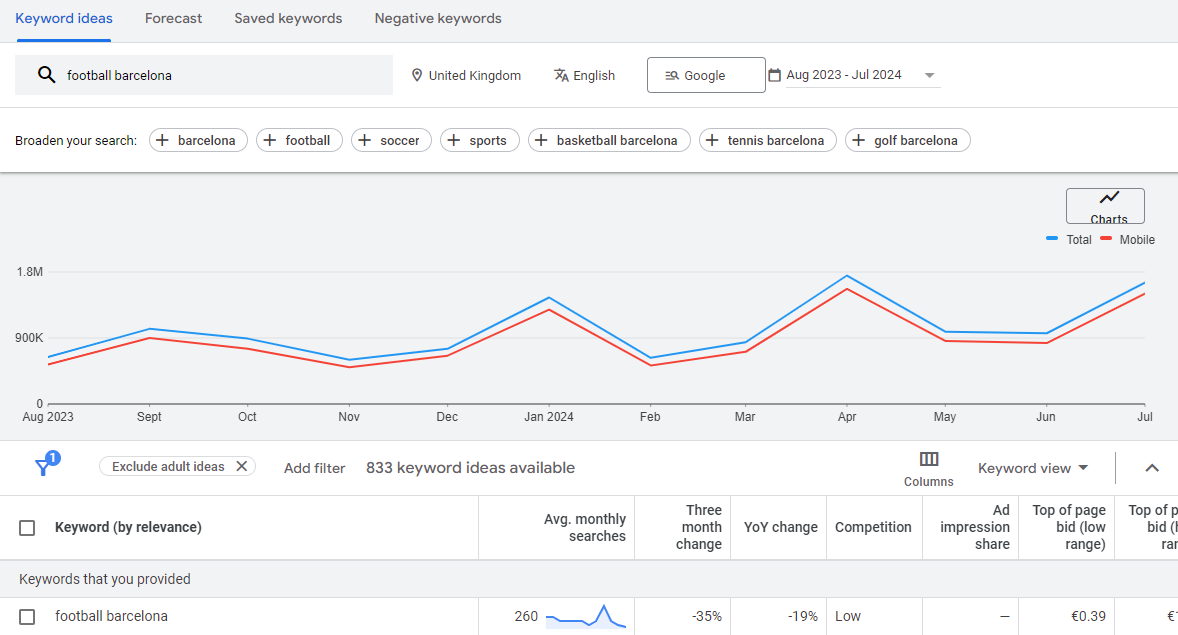
If you are in your Google Ads account, go to the Google Keyword Planner. By default, the Google Keyword Planner does not show results for Google search queries. You need to select ‘Google search’ as your search type and your target country in the drop-down menus. Not only can you enter your keyword, but you can also add multiple keywords. Use inverted commas for an exact search. Want to refine your search? Then filter by match type, search volume range and competition level.
Google Trends
Perfect for determining search volume by seasonality and location. It calculates how search interest changes. It can also be compared with other keywords. This search volume represents the relative popularity of the search term in a specific period. The index between 1 and 100 therefore does not describe its monthly search frequency. It therefore makes it possible to recognise seasonal trends and compare the interest in different keywords.
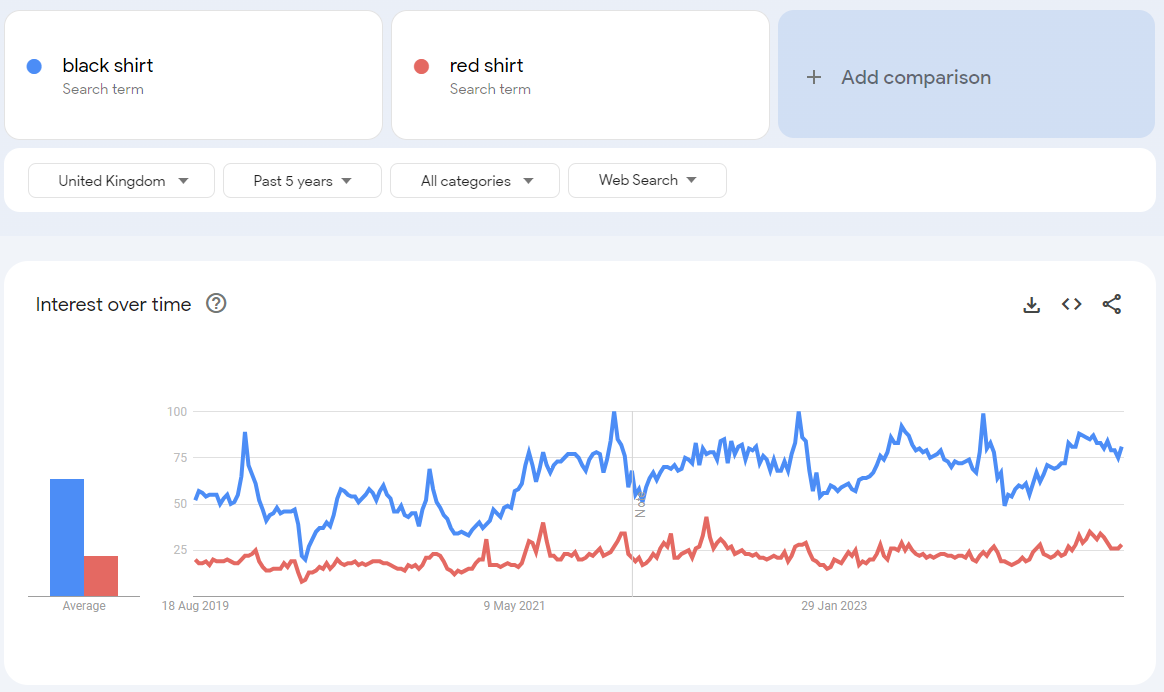
When you are on the Google Trends homepage, click on ‘Explore’. Enter the keyword that interests you. The main curve shows how the interest in this search term has developed. If you place your cursor on the curve, the search volume index is displayed. To refine your search, you can play with different variables. For example:
- Category
- location
- time period
- Type of search
If you enter several terms, Google Trends compares their search volume indices in separate curves.
Google Search Console
This is the tool that helps you measure the performance of your website. Search Console does not provide the exact search volume. Instead, it takes into account several factors to determine the traffic for each search term. For example:
- the total number of clicks
- the total number of impressions
- the average position in a search engine
- etc.
Firstly, you need to log in to the Search Console. Then select the website you want to receive information about. Click on the ‘Performance’ tab in the left-hand menu. In this report you will be able to analyse the different factors. You can then estimate the search volume.
Free and paid alternatives to the Google suite
Ubersuggest
If your main goal is to increase your conversion rate, Ubersuggest is the ideal tool. It has the ability to analyse competing websites. This allows you to find out which keywords your competitors are ranking for. This includes keyword suggestions and ideas for optimising your content. Ubersuggest has limited, free features. Want a fairer and more balanced experience? Then you should opt for the paid version.
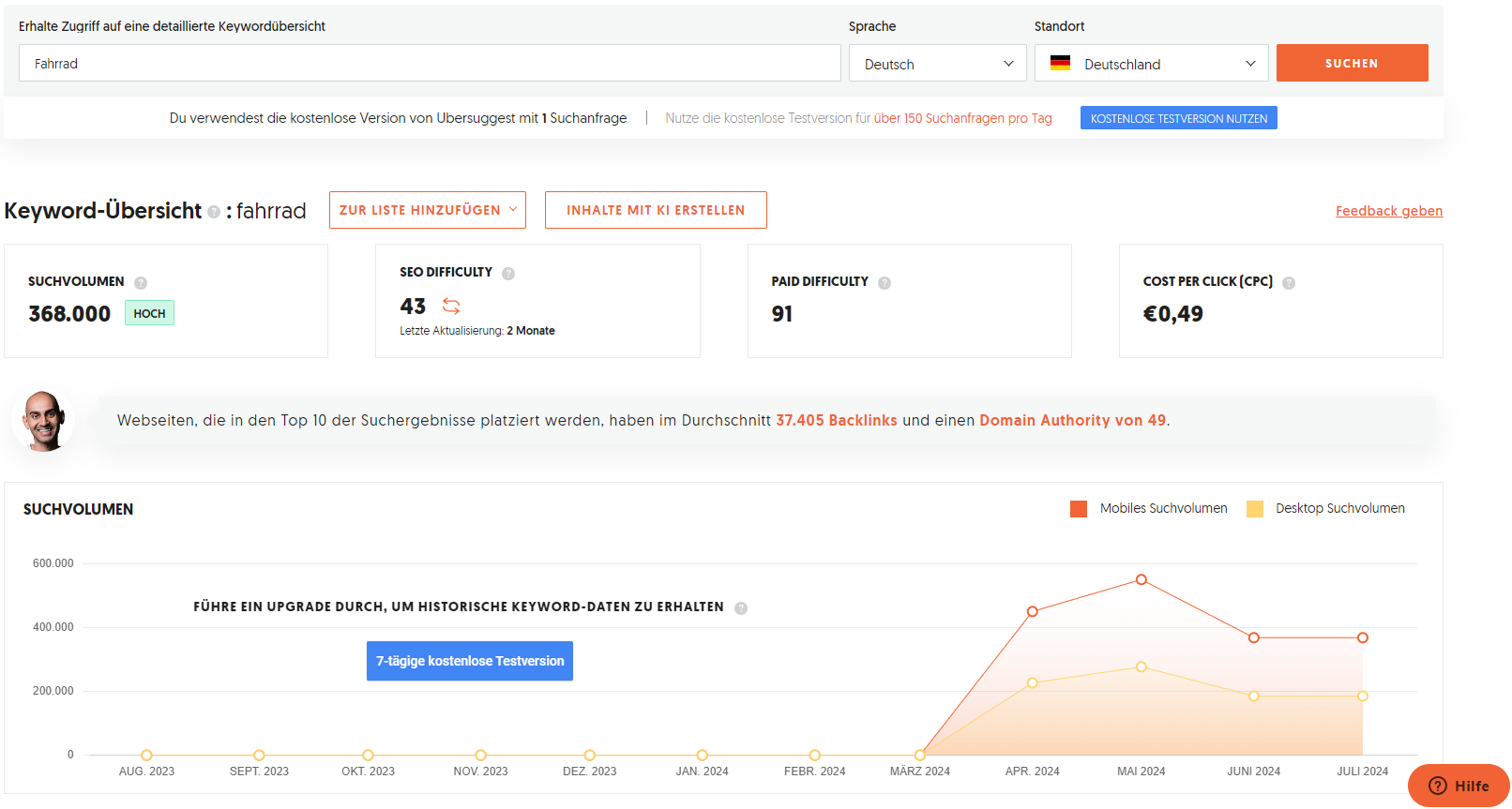
Enter the search term or group of search terms on the main page. By default, Ubersuggest displays an overview for the entered term. The search volume is displayed in the form of a numerical value and a graph. While the numerical value is freely accessible, this is not the case for the graph. The ‘Overview’ report provides further indicators
- SEO difficulty (assessment of the competition in organic search)
- Paid difficulty (assessment of the competition in paid search)
- Cost per click
SemRush
SEMrush is the tool that combines all the functions necessary for SEO. It is very comprehensive in its analyses. Reveal competitively relevant information. For example, the positioning of other websites for certain keywords. It is possible to create a free account. However, it is advisable to create a paid account. This will give you access to all available functions.

Go to the ‘Keyword overview’ tool. It is located in the search bar at the top of the screen. Then enter the search term. SEMrush will then display the results for the country you are in and for the global database. You can refine your search by selecting a country and database. The report shows three types of search volume for the keyword: monthly, organic and paid. Search volume trends, CPC, competition of the keyword, suggestions for related keywords…
Ahrefs
If SEMrush is the heads side of the ‘SEO tool’ coin, then Ahrefs is the flipside. It is known for providing very strong backlink analyses. But you can also use it to analyse search volume. By checking other competing websites, it can provide you with a list of suggested keywords. You can opt for a free trial version. With the paid subscription, you can use the full range of functions.
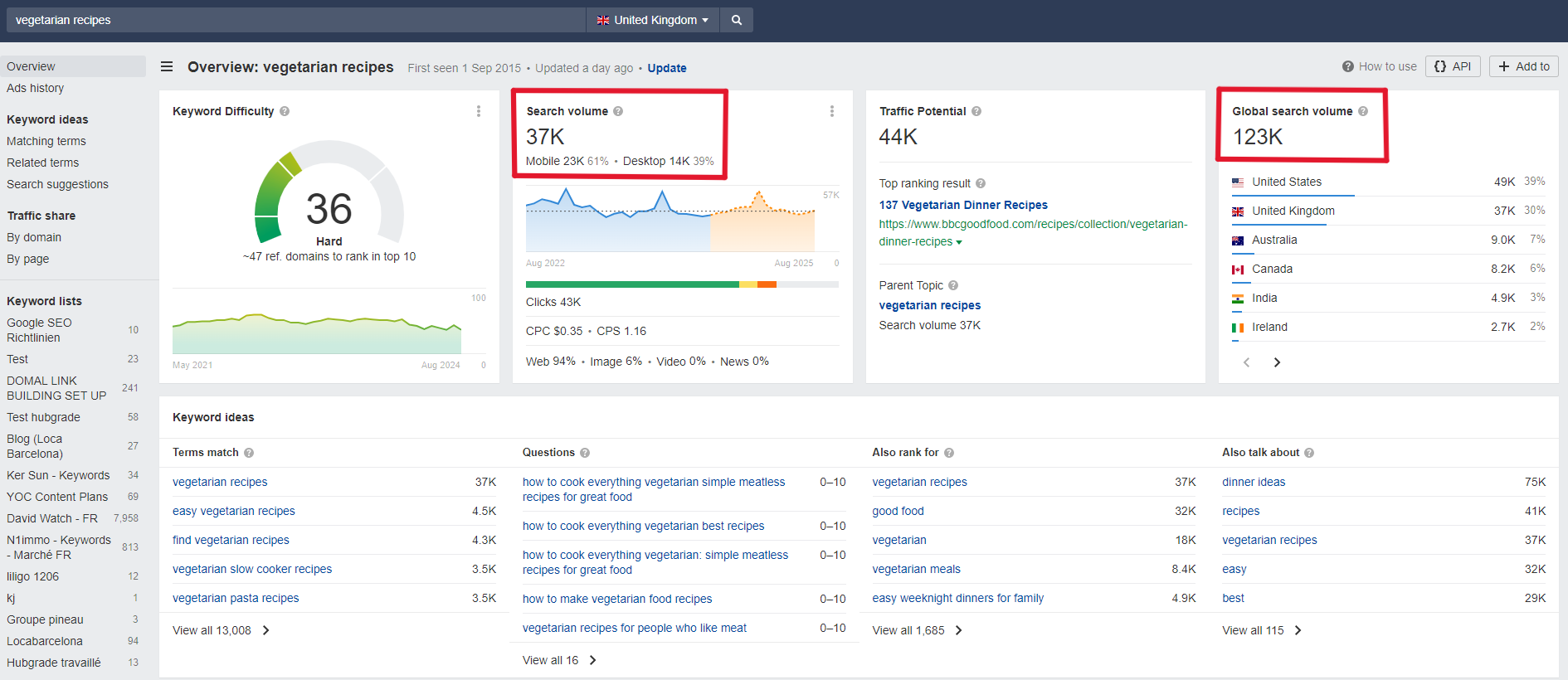
Select the Keyword Explorer in the main navigation bar. Ahrefs will then display results for the country you are in by default. Refine your search by selecting a specific country and language. Like SEMrush, it generates three search volumes: global, organic and paid. You can add value to your search volume analysis. To do this, explore the various additional data:
- CPC
- Difficulties in the placement of the search term in relation to organic search results
- Frequently asked questions from users about the term
- etc.
Keywords Everywhere
This is a Chrome or Firefox extension. It displays the following data during your internet search:
- Search volume of the search term in certain time periods
- CPC
- Suggestions for similar search terms such as long-tail keywords
You must use the paid version to see the search volume.
Install the Keywords Everywhere extension. Register on the Keywords Eveywhere website. Choose the free or paid plan depending on your needs. Once you have your account, activate the extension in your browser.
Wordstream
It is very easy to use. The tool allows you to target the search volume to the selected country and industry. However, it is not precise enough.

Set up an account. Then go to the ‘Keyword Tool’ located in the main navigation bar. Enter the keyword in the search bar in the centre of the page. Wordstream will then display a tab. You can use this to refine the search by selecting the country and industry. By default, this will display all industries and the USA as the location. The report then shows the following:
- The monthly search volume
- The cost per click from the lowest to the highest value
- The competition of the keyword using the terms ‘low, medium and high’.
Further additional information can enrich your analysis
- The average cost per click
- Trends in search volume
- Suggestions for terms that are relevant to your sea
Moz
Its use is recommended for companies that want a low search volume. This is because this tool is suitable for niche-orientated search terms. It is possible to filter the frequency of search terms by country. Even though Moz offers some basic functions for free, a subscription is required. This is the only way to deepen your analysis.
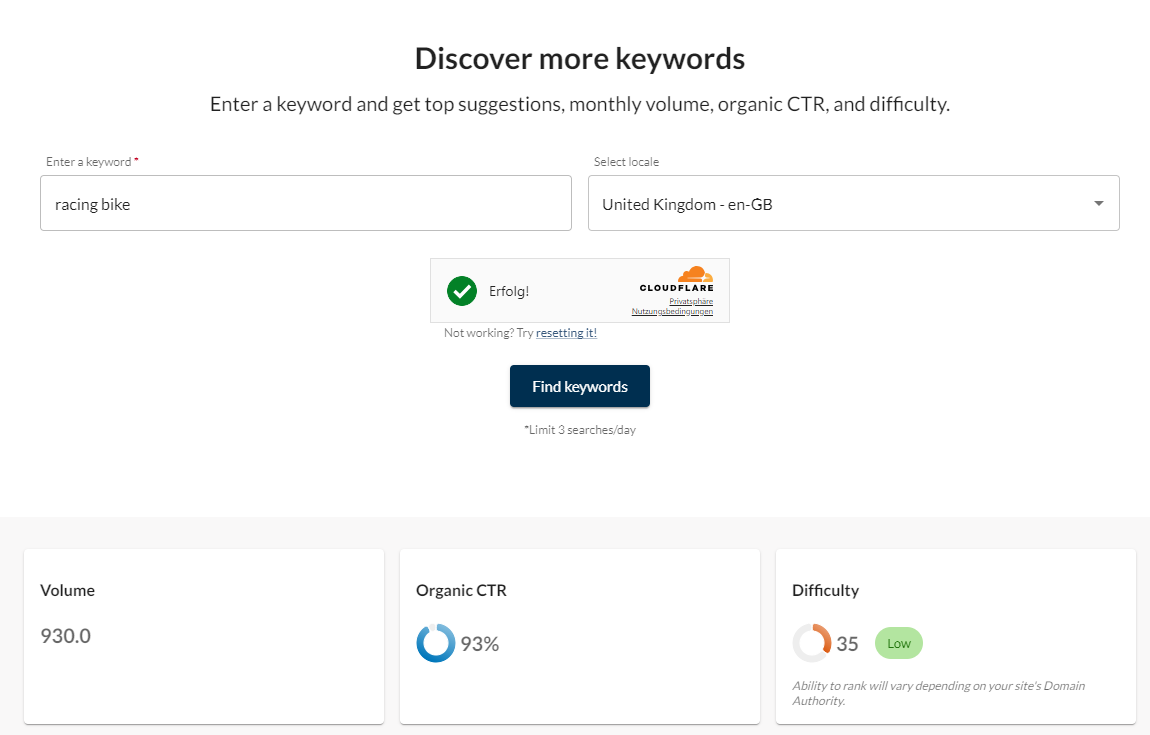
For free use, click on the ‘Free SEO Tools’ tab on the main page. Then select the ‘Keyword Explorer’ function. Enter the search term you are interested in and select your location. This will show you
- the monthly search volume
- the organic click-through rate (organic CTR)
- the competition of the keyword
If you have a business account, you must also select the ‘Keyword Explorer’ function. Enter the keyword you are interested in. The ‘Keyword Explorer’ also provides further valuable information. These are related search terms, SERP analysis and link opportunities.
Is this a useful metric for an SEO strategy?
Knowing the search volume of a search term is an essential criterion in SEO. This is the only way to find the ‘right’ search terms with which you can optimise your SEO ranking. But be careful: the search volume is more of an estimate than a result. It is influenced by several factors, such as seasonality or location. Keyword selection is not the only lever that will improve your SEO. Contact Keyweo to find out how you can optimise your search engine results.
The most popular definitions
product description
landing page
app store optimisation
bounce rate
google panda
money site
vertical search engine
link buying platform
Search Volume
White Hat SEO
Boost your Visibility
Do not hesitate to contact us for a free personalised quote
Notez ce page







